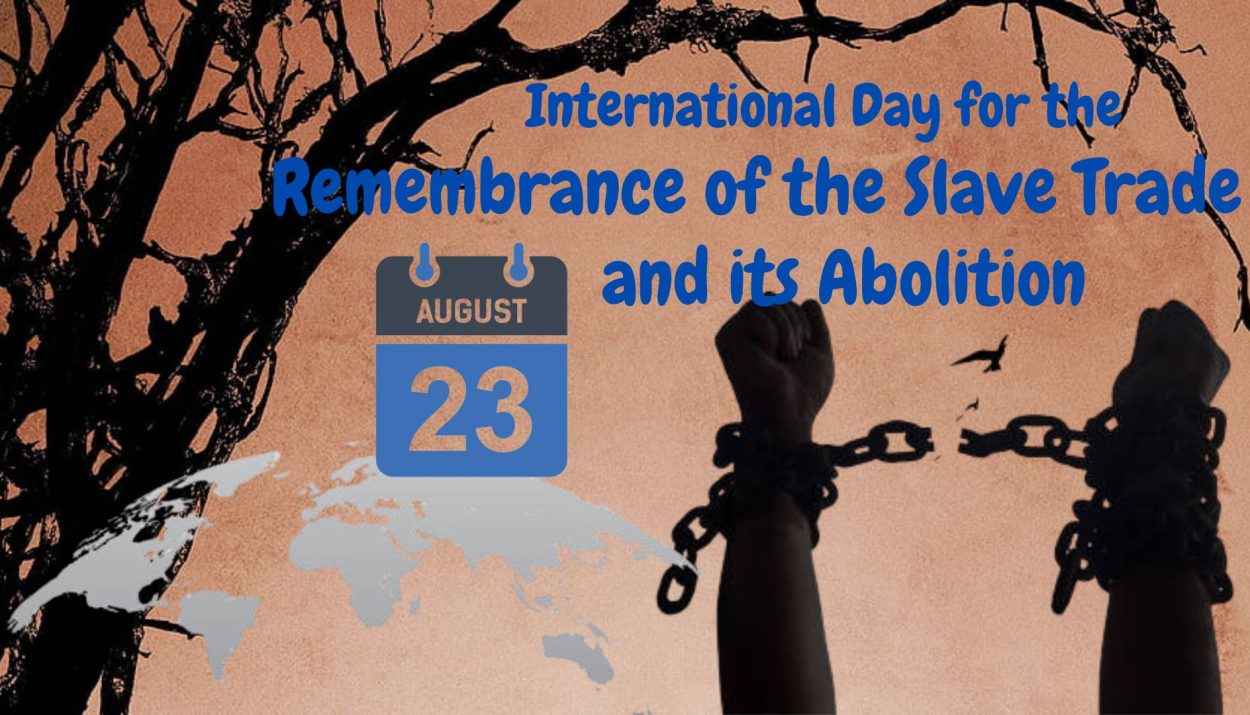In the late hours of August 22nd to August 23rd, 1791, the region known as Saint Domingue, now the Republic of Haiti, witnessed the inception of an uprising that would prove pivotal in ending the transatlantic slave trade. In 1997, UNESCO designated August 23rd as the International Day for the Remembrance of the Slave Trade and its Abolition. Its initial observance took place in several nations, notably in Haiti on August 23, 1998, and on Gorée Island in Senegal on August 23, 1999.
The theme for 2023 is: “Fighting slavery’s legacy of racism through transformative education.”
This solemn day serves as a reminder of one of the darkest chapters in human history, a period marked by the brutal transatlantic slave trade and the subsequent abolition efforts that eventually led to the end of this inhumane practice. The observance of this day offers an opportunity for reflection, education and a commitment to never forget the profound suffering endured by millions of enslaved individuals and their enduring legacy in the struggle for freedom and equality.
Definitions
- According to the Merriam-Webster Dictionary:
A slave is a person held in forced servitude.
Slavery is the practice of slaveholding.
- According to the Cambridge Dictionary:
A slave is a person who is legally owned by someone else and has to work for that person.
Slavery is defined as the activity of legally owning other people who are forced to work for or obey you.
The History of the Transatlantic Slave Trade
The transatlantic slave trade, which spanned over four centuries, remains one of the most horrifying and morally reprehensible episodes in human history. Beginning in the 16th century and lasting until the 19th century, European powers engaged in the systematic capture and forced transportation of African men, women and children to the Americas. These individuals were torn from their homes, families and cultures, enduring unimaginable suffering during their journey across the Atlantic Ocean in what became known as the Middle Passage.
The Transatlantic Slave Trade evolved into a triangular trade system. European ships would sail to Africa, where they would trade goods for enslaved Africans. These captives were then transported to the Americas, mainly to work on plantations, in mines or as domestic servants. The final leg of the triangular trade involved the shipment of American-produced goods, such as sugar, tobacco, cotton, and rum, back to Europe.
Once in the Americas, these enslaved Africans were subjected to inhumane treatment, forced labour and unimaginable brutality. The legacy of this brutal trade continues to shape the social, economic and political landscapes of countries in the Americas and Africa.
The Abolition Movement
Despite the immense profits generated by the slave trade, a growing moral and ethical consciousness began to emerge in Europe and the Americas. Abolitionists, both black and white, worked tirelessly to bring an end to this barbaric practice.
Prominent individuals involved in this effort included Olaudah Equiano, a former enslaved person who successfully secured his own freedom and authored a highly praised book. Additionally, William Wilberforce emerged as a strong advocate for this cause, taking the fight to the chambers of Parliament.
The efforts to end the slave trade took various forms, from grassroots activism and political lobbying to public awareness campaigns and legal battles. The British Parliament passed the Abolition of the Slave Trade Act in 1807, followed by the Slavery Abolition Act in 1833, which marked the beginning of the end of the transatlantic slave trade.
By 1838, all enslaved individuals within the British Empire who had been part of this trade were officially granted their freedom. Nevertheless, the institution of slavery persisted in various other regions.
The Significance of Remembrance
The International Day for the Remembrance of the Slave Trade and its Abolition carries immense significance for several reasons:
Education: It provides an opportunity to educate people worldwide about the horrors of the slave trade and the heroic efforts of abolitionists who fought against it. Understanding this history is essential to ensure such atrocities are never repeated.
Honouring the Victims: This day serves as a tribute to the millions of enslaved individuals who endured unimaginable suffering. It acknowledges their resilience and courage in the face of adversity.
Reflecting on Progress: It offers a chance to reflect on the progress made in the fight against racism, discrimination and inequality, as well as the work that still remains to be done to achieve true racial justice and equality.
Promoting Unity: Observing this day promotes global unity in acknowledging a shared history and working together to combat racism and discrimination in all its forms.
Inspiration for Change: It inspires individuals and communities to take action against modern forms of slavery, human trafficking and discrimination, ensuring that the legacy of the abolitionist movement lives on.
Conclusion
The International Day for the Remembrance of the Slave Trade and its Abolition is a day of reflection, remembrance and renewal of our commitment to a world free from racism, discrimination and the enslavement of any human being. It reminds us that the struggle for justice, equality and human dignity is ongoing and that we must continue to work together to ensure that the horrors of the transatlantic slave trade are never forgotten and never repeated. By acknowledging our past, we pave the way for a more just and equitable future for all.
On this occasion of International Day, let us unite in our stance against racism and collectively construct societies founded upon principles of dignity, equality and solidarity.
References
International Day for the Abolition of the Slave Trade: What does this mean?- BBC
transatlantic slave trade- Britannica
Remembering victims of the slave trade
